AEON – A keystone to sustainable green aviation!
- Like
- Digg
- Del
- Tumblr
- VKontakte
- Buffer
- Love This
- Odnoklassniki
- Meneame
- Blogger
- Amazon
- Yahoo Mail
- Gmail
- AOL
- Newsvine
- HackerNews
- Evernote
- MySpace
- Mail.ru
- Viadeo
- Line
- Comments
- Yummly
- SMS
- Viber
- Telegram
- Subscribe
- Skype
- Facebook Messenger
- Kakao
- LiveJournal
- Yammer
- Edgar
- Fintel
- Mix
- Instapaper
- Copy Link
Posted: 20 July 2021 | Mathieu Cousy, Murali Varadarajan, Paola Lanzi | No comments yet
Murali Varadarajan, who is currently in charge of developing the Concept of Operations (CONOPS) for the Advanced Engine off Navigation (AEON) project, talks to International Airport Review about the project and how it is working towards a sustainable future for aviation.
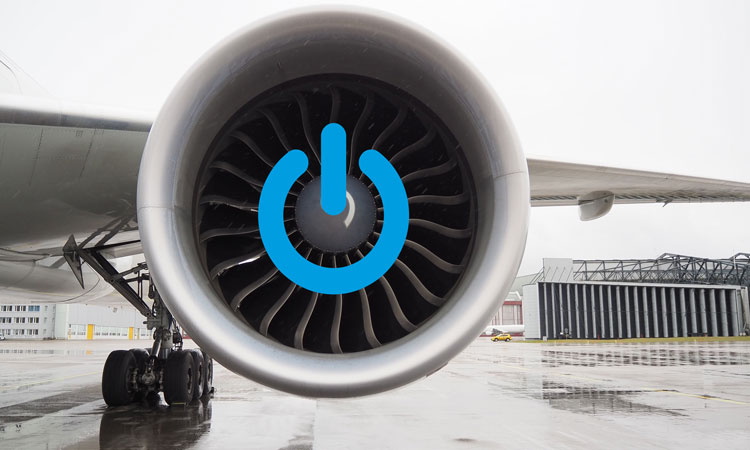

The aviation sector is known as one of the most polluting means of transportation, to the point that it is the target of an anti-flying social movement called ‘flygskam’ or flight shaming. Commercial flights contribute to about 2.1 per cent of global CO2 emissions, to which are added other gas emissions like nitrogen oxide and water vapour as contrails. Most research on new technologies aim at improving flight efficiency with a wide variety of levers from aircraft design and sustainable aviation fuel (SAF) to smoother air traffic management (ATM). However, it is often forgotten that aircrafts also spend considerable time on the ground, where they are far from efficient.
Statistics published by the International Civil Aviation Organization (ICAO) in 2019, provide an in-depth analysis of aircraft passengers, number of ground movements and the amount of fuel consumed that year, especially when it comes to fuel consumption during aircraft taxiing. Pre-COVID (2019) traffic figures show that airlines carried 4.5 billion passengers, 46.8 million scheduled commercial flights handled with 8.6 trillion revenue passenger kilometres (RPK) flown by 1,478 commercial airlines between 3,780 airports (with scheduled commercial flights) around the world. This massive scale of operation contributed to about 368 billion litres (or 290 million tonnes) of jet fuel consumption, amounting to 23.7 per cent of airline expenses and an astounding amount of CO2 emissions (about 914 million tonnes). This is a mind-boggling figure!
This alarming rate of increase of CO2 and other emissions can be compared as seen in Fig. 1 below. The noise and emissions have grown slower than PKM, but emissions have grown faster than number of flights. It is also important to note that over the years aviation stakeholders have made substantial efforts to bring down emissions through technological and operational effectiveness with large capital expenditure (CAPEX) on infrastructural and structural improvements, such as airlines spending about $1 trillion on 15,000 new aircraft since the last decade. Yet, we are miles away from reaching our destination.
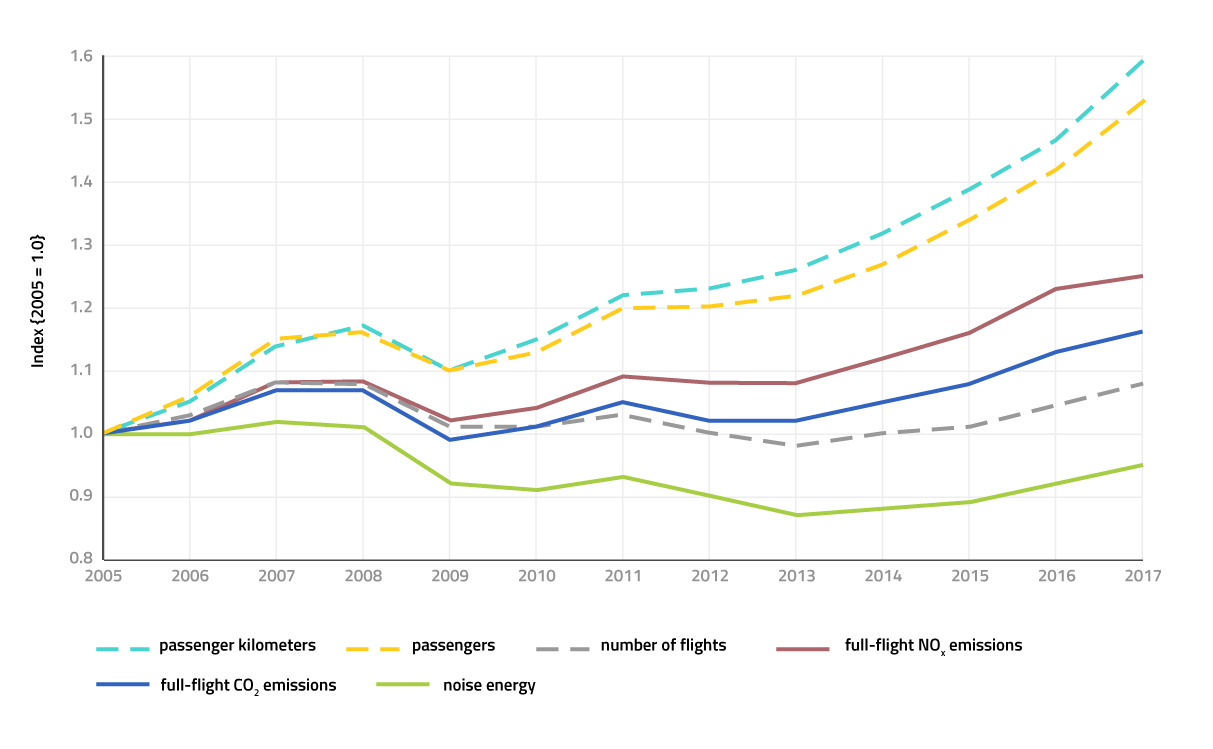

Fig. 1: Noise and emissions grow slower than passenger kilometres but emissions grow faster than number of flights
The Paris Agreement brought 193 member states of ICAO (representing 68 per cent of the global economy) to come up with action plans that would unilaterally and collaboratively bring down the global carbon emissions to a “net zero” level by 2050. This indeed puts considerable amount of pressure on both airports and airlines to re-align their sustainable strategies, even while they are still grappling with the COVID-19 crisis. At the same time, it gives room for innovation when all aviation stakeholders work together with technology providers to arrive at a holistic, viable and sustainable alternative to decarbonise not only the airspace, but also the ground operations. All this and more is to be achieved, keeping in mind not to sacrifice the shared connections among key players in aviation and adopt an approach that would bring about seamless business continuity. One such innovative approach on ground is the AEON project (Advanced Engine Off Navigation).
AEON has received funding from the Single European Sky ATM Research (SESAR) Joint Undertaking under the European Union’s Horizon 2020 research and innovation programme under grant agreement No 892928. The project is coordinated by ENAC (Ecole Nationale de l’Aviation Civile, France) in collaboration with Deep Blue, Italy and TU Delft, Netherlands. Its primary aim is to define a Concept of Operations (CONOPS) for engine-off taxiing techniques, making use of novel technologies that are coming onto the market, such as TaxiBots, E-Taxi (using nose landing gear or main landing gear) and Single Engine Taxiing.
The ground reality
The ICAO emissions certification standards are designed to regulate smoke and various gaseous emissions from aircraft engines, including unburned hydrocarbons (HC), carbon monoxide (CO), nitrogen oxides (NOX) and non-volatile particulate matter (nvPM). The smoke limit was set to control visible emissions, whereas the limits for gaseous emissions were set to address local air quality issues in the vicinity of airports using a reference Landing and Take-Off (LTO) cycle as the basis for the calculation of the mass of gaseous emissions (Fig. 2). We can also see that during the LTO cycle, maximum time (about 26 minutes) is spent by aircrafts while taxiing, though at a lower thrust. This implies, corresponding emission of various gases that affect the local air quality and noise at airports.
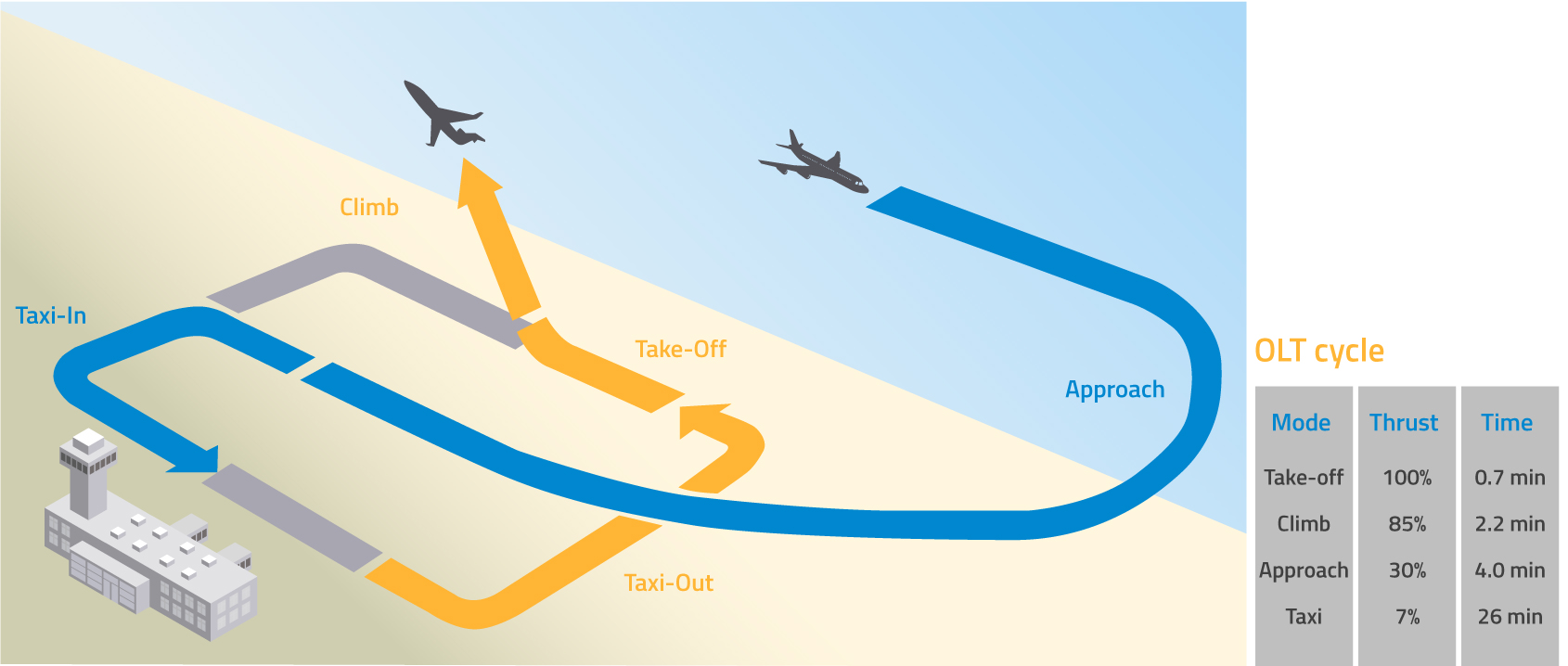

Fig. 2
In 2019, it is estimated that airports handled an average of 140 million aircraft ground movements. The average fuel consumption during such ground operations is calculated to be about five per cent of the total quantity of fuel used during flight from apron to apron. This value of consumption is approximately five million litres of jet fuel per day, corresponding to about 12,750 tonnes per day of CO2 emission.
Such a quantum of emissions may prove to be costly to the airport environment, if adequate measures are not taken in the short- and medium-term. In order to achieve SESAR’s “net zero” goal by 2050, substantial improvements are needed in aircraft technology, SAF and efficient, electric or engine-off (EEE) aircraft operations. Different approaches, for both airborne and ground operations, have been proposed to reduce and control emissions without compromising techno-economic viability. For on-ground activities, sustainable taxiing methodology can make the most significant difference in reducing emissions and noise at the airports. For airlines, this would mean a substantial lowering of fuel consumption and operating costs. It is this significant difference that project AEON will address and provide a roadmap to seamlessly integrate various E-Taxi techniques using human machine interface enabled interface into airport collaborative decision-making platforms.
The concept
The AEON project’s objective is to provide innovative, sustainable engine-off methodologies to achieve a basket of measures such decarbonisation, noise reduction etc. into day-to-day ground operations of the airport. Fig. 3 shows the layout of AEON project defining the CONOPS for engine-off taxiing techniques, making use of novel technologies that are coming into the market, such as:
- Non-autonomous taxiing, such as TaxiBots, a hybrid towing vehicle which, unlike the normal pushback trucks, can tow full aircrafts to near the start of the runway, without the aircraft having to start its engines. This is expected to reduce fuel consumption during taxiing by 50- 85 per cent.
- Autonomous taxiing like E-Taxi system, which relies on electric motors embedded in landing gear/nose wheel gear to allow planes to push back and taxi without their jet engines running – saving fuel, curbing emissions and ending last-minute delays while waiting for airport tugs. This is expected to imply a reduction in fuel costs of around four per cent of the overall consumption, considering a 50 per cent taxi fuel saving and up to 85 per cent of ground operations costs-savings considering other benefits like pushback costs, brake wear etc.
- Single engine taxiing, which involves the use of only half the number of engines installed to generate the energy needed for taxiing, reducing taxi fuel consumptions by 20 per cent.
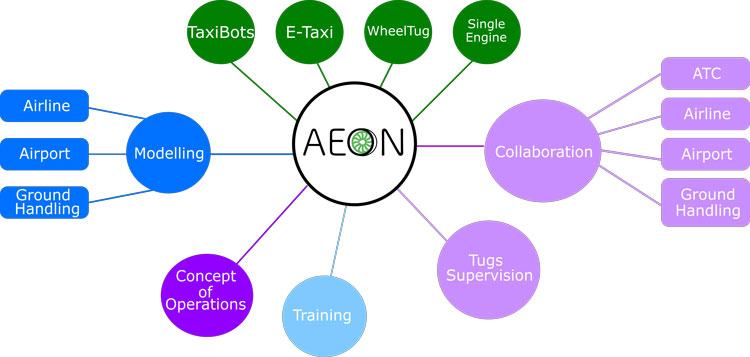

Fig. 3
As explained in the European Aviation Environmental Report (2019), Airport Collaborative Decision Making (A-CDM) aims at improving the overall efficiency of airport operations, especially on aircraft turn-round and pre-departure sequencing processes. The A-CDM can improve predictability but the AEON project believes it can also foster better allocation of taxiing techniques, taking into account every constraint. AEON (as shown in Fig. 3) will provide modelling tools that collaborate with aviation stakeholders and also focus on real-time management of taxi operations – especially tug fleet supervision, training of resources, remaining taxi time information and speed targets to smooth traffic.
The AEON project partners will work closely with airports, airlines and manufacturers on developing the following:
- Overall aircraft engine-off navigation CONOPS, detailing how three or more eco-friendly solutions may combine in the airport surface management process both at strategical and tactical levels in order to minimise fuel consumption and emissions without impacting arrival and departure flight schedules;
- Business model to help airports and/or airlines evaluate their benefits in implementing these technologies;
- Testing by simulating high traffic airport operational environment (use cases) to arrive at a viable engine-off solution, which can then be integrated effectively into airport collaborated decision-making tools.
- Real-time evaluation of environmental indicators to support collaborative decision-making, conflict-free routing for all vehicles, reallocation of techniques to adapt to in real-time.
Over the years original equipment manufacturers (OEM) such as Airbus, aerospace companies such as Safran and airports such as Schiphol, along with technology providers such as SAS (Smart Airport Systems) have undertaken extensive research work in E-taxiing and invested in technologies that support AEON’s common objective. The SAS TaxiBot operation with KLM airlines has been successfully tested at AMS and the outcome as per To70 aviation consultant’s report has been very encouraging. Companies such WheelTug also offer sustainable alternative taxiing methods for narrow body B737’s and A320’s that are in the process of certification. It is also said that with an immediate step to reduce carbon footprint at airports, France could be the first country in Europe to come up with a new norm to enforce single-engine taxi at all their airports. Airport groups such as Aéroports de Paris and Royal Schiphol Group have set forth ambitious programs to cut emissions at their airports worldwide. Both Eurocontrol and DSNA are working closely to support and bring about necessary changes to the aviation landscape with a focus on economic and environmental benefits to the community as a whole.
AEON – The new age PPP!
Aviation is an integral part of any future transport ecosystem. It provides overall global mobility and is in many cases the only practical connection in a national and international context.
Companies across the sector are collaborating to reduce emissions using a four-pillar strategy of new technology, efficient operations, improved infrastructure and market-based measures to fill the remaining emissions gap. Modern jet aircrafts are 75 per cent quieter than the models that first entered service, and each new generation of aircrafts continues this downward trend.
Today’s sustainable aviation fuels can reduce CO2 emissions by up to 80 per cent over their lifecycle as compared with fossil fuels. However, it is not clear when that tipping point would occur for these fuels to power at least two per cent of the commercial aircrafts.
We believe that the AEON project could follow a new age PPP approach to protect, preserve and prepare a roadmap towards sustainable aviation. It would protect the air transport without sacrificing shared connections to each other and the world, preserve to the extent admissible the existing airport ground environment by carefully identifying and integrating those viable green technologies that sync with existing operations and finally prepare a clear road map in line with SESAR JU’s goal of achieving greener ground operation footprint at airports.
In a message to the G7 leaders shortly after the outcome of the summit in June 2021, esteemed Naturalist, Sir David Attenborough, said: “We have the skills to address climate change in time. All we need is the global will to do so.” In our opinion, AEON project is one such climate change keystone in aviation that, with a global will can metamorphose the shape of ground operations and underpin a sustainable economic growth for a resilient green aviation future.
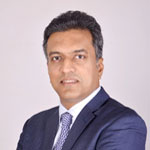

He was formerly, Senior Vice President and Head of Operations of Mumbai International Airport Limited (MIAL). He was responsible for the Integrated Terminal Operations of T2 and T1 and Corporate Aviation Terminal. He oversaw Facility Management & Customer Service divisions for the airport. His key responsibilities included stakeholder management, enhancing passenger experience and aid in seamless travel. His role was to provide strategic guidance and bring in operational efficiency into terminal and facility management with an aim to provide the highest quality of passenger service.
Prior to assuming this new role, Murali held several general management and corporate strategic planning positions for 10 years with the GVK Group and over seven years of rich experience in the field of Airport Planning & Management. He has led the Airport Planning Group at MIAL and provided leadership to their airside design team.
He is currently doing advanced master’s course at Ecole Nationale de l’Aviation Civile (ENAC, Tolouse, France). He also holds a bachelor’s degree in architecture and master’s in Building Technology and Construction Management from the Indian Institute of Technology (IIT), Chennai, India and completed his Executive MBA from the Indian Institute of Management, Bangalore.
Co-authors


Deeply involved in the scientific research on the integration of humans and technology for innovation, she is experienced in managing projects dealing with the design and validation of new concepts of operations for aviation and air traffic management, the organisation and conduct of human-in-the-loop experiments and the dissemination of scientific project results to different key audiences and stakeholders. She also contributed to designing and developing guidelines and methodologies for HF assessment and some of the Validation and HP Assessment Processes used in the field such as E-OCVM and the SESAR HP Assessment Process.
Since 2011, she has been promoting the research on liability impact of automation as a means to feed the design process of new automated technologies for air traffic management, aviation and safety-critical domains in general. In this specific area, she is one of the designers of the Legal Case method, being successfully used for the proactive assessment of liability implications of new concepts of operations and tools. Her work has been published in national and international peer-reviewed journals and books.
In AEON she coordinates the work related to the development of the concept of operations and the scientific dissemination and exploitation of project results.


He has been involved in various projects around ATC (approach control position simulator) and aeronautics (flight management system, electronic flight bag). He is also a certified scrum master and has several experiences as Agile project management coaching. Since 2013, Mathieu has joined ENAC to work on Sesar WP-E project MoTa as project leader.
Therefore, he worked on a tower control position as well as its integration in ENAC simulation facilities. Then he has been highly involved in different airports oriented SESAR projects (MOTO, ENVISION). He is now coordinating AEON project.
Related topics
Emissions, Social responsibility, Sustainability, Sustainable Aviation Fuel (SAF), Sustainable development


















